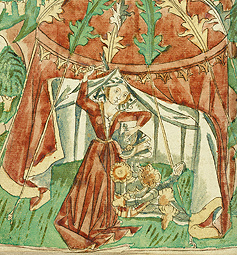|
The Old Testament (the Hebrew Bible modified and reordered for Christian use) served as one of the richest sources for narrative art in the Middle Ages. It provided familiar stories–such as those of the Creation of the World and Noah's Ark–and held up heroes such as David and Solomon for emulation.
Medieval readers turned to the Old Testament not only for inspiration and moral guidance, but also as a source of entertaining tales and historical information. This exhibition features illustrations of the Old Testament in a wide variety of books, including: Bibles, private devotional manuscripts, books for the mass, and world histories.
This image of the Old Testament hero Samson with a lion is taken from a page of a "bestiary," or medieval encyclopedia of nature, that also includes moralizing lessons. Samson's identity is confirmed by such details as his long hair, the source of his strength, and his closed eyes. Behind the figures, a delicately painted graphic background repeats heraldic images of the fleur de lys and a cathedral.
|
 |
|
The term "Old Testament" refers to the first part of the Christian Bible, which derives from the Hebrew scriptures. Medieval Christians believed that the prophecies of Hebrew sacred texts were fulfilled in the life of Jesus Christ.
|
 |
|
|
 |
|
The narratives of Christ's life found in the four Gospels, along with his disciples' writings, were thought to comprise a New Testament that completed God's will for mankind. Christianity incorporated the Hebrew scriptures through translation. Pictures in medieval Bibles clarified Christian attitudes toward the Old Testament and indicated which sections were deemed most instructive.
|
 |
 |

 |
 |
Judith Beheading Holofernes (detail), in Barlaam and Josaphat, Alsatian, 1469
|
 |
 |
|
Medieval people looked to the wise and courageous figures of the Old Testament as models of behavior. They depicted them in the public sculptures of the grand cathedrals of Europe and the illuminations of private prayer books.
Bishops, priests, and monks looked to the examples of prophets and spiritual guides such as Moses; a brave king or knight might have styled himself after David or Samson; and a queen who judiciously safeguarded her people in a time of peril might have earned comparison to Esther. To enhance the Old Testament's relevance and impact for these audiences, artists portrayed biblical heroes and heroines in contemporary costume and illustrated their most exemplary and memorable deeds.
Judith was a pious widow who brought salvation to the people when the Assyrian general Holofernes threatened to destroy Israel. Having surrendered herself to the enemy and convinced Holofernes of her loyalty, Judith entered his tent while he was sleeping and cut off his head with his sword. In this picture, Judith prepares to behead the general with a hammer and stake rather than the sword specified in the biblical text.
|
 |

 |
 |
The Crossing of the Red Sea; The Egyptians Engulfed, (detail), in World Chronicle, German, about 1400–1410 with addition in 1487
|
 |
 |
|
|
 |
Medieval authors made scripture available to a wide audience by translating and paraphrasing Old Testament stories. They retold the sacred narratives of the Old Testament and, according to the conventions of popular romance and court culture, embellished them with anecdotes based in history and legend rather than the Bible.
Historical chronicles included exciting Old Testament tales, and frequently rhymed for the entertainment of aristocratic audiences. Manuscript illuminators responded to these changes by illustrating biblical episodes in contemporary settings and presenting the Old Testament in images of adventure and high drama.
|
 |
|
According to medieval Christian doctrine, the Old Testament found its fulfillment in the New Testament. In this way, authors of Old Testament prayers and prophecies, such as King David or Job, effectively directed readers to the salvation provided by Christ. This view governed the role of Old Testament pictorial themes in liturgical manuscripts, especially books for prayer. Old and New Testament events were often depicted in parallel so that worshipers could contemplate how the Old foreshadowed the New.
The scene of Moses and the Brazen Serpent is from the Old Testament book of Numbers. When the Israelites were bitten by poisonous snakes, the Lord ordered Moses to set a bronze serpent on a pole, so that those who gazed upon it might be saved.
In manuscript form, the artist displays this image opposite an image of Christ on the cross to encourage the viewer to contemplate Christ's imprint on the entire history of salvation. In John 3:14, Christ draws an analogy between this event and his imminent Crucifixion: "And just as Moses lifted up the serpent in the wilderness, so must the Son of man be lifted up, that whoever believes in Him may have eternal life."
|
 |





